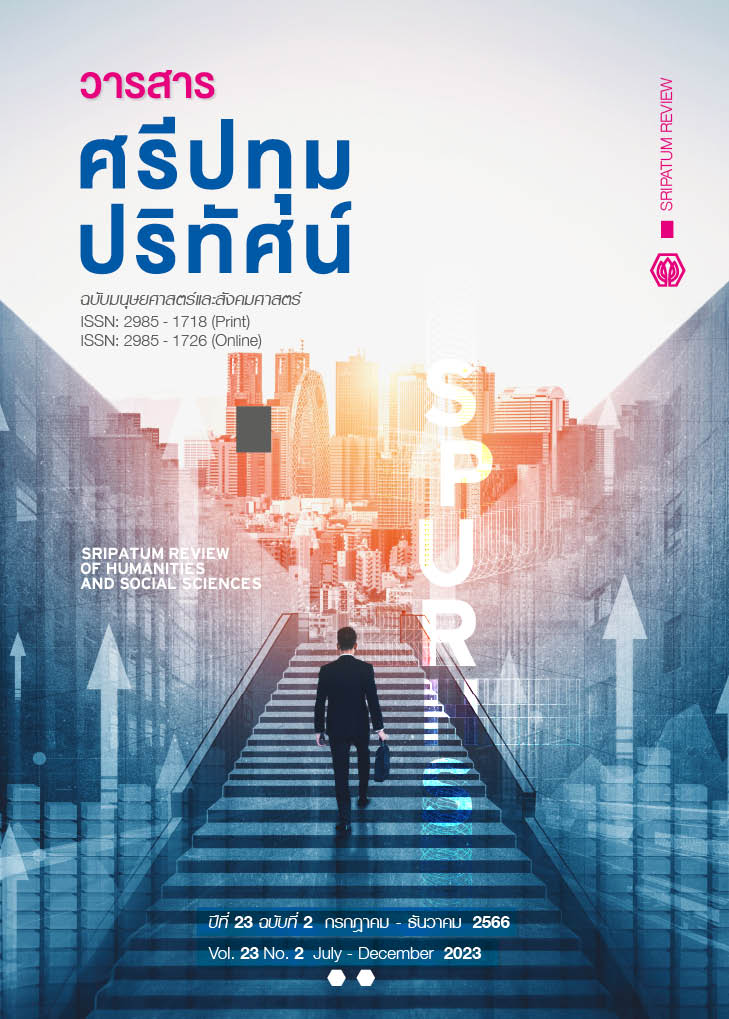Causal Relationship Model of Political Parties’ Branding of Thai National University Scholars
Main Article Content
Abstract
This research aimed to develop and validate the causal relationship model of political parties' branding of Thai national university scholars, which was a quantitative research. The questionnaires were collected from 718 samples. All that participated in the study were undergraduate scholars of the top 10 scholars count in the national universities. The samples were obtained using a multi-stage sampling technique for developing and validating Structural Equation Modelling (SEM) to analyze the effect of factors on the political parties' branding, such as 1) Visual Identity, 2) Person, 3) Highlighted Policy, and 4) Political Parties' Branding.
The results found that (1) Visual Identity has a positive correlation with Political Parties' Branding, with a correlation coefficient of 0.83, Person has a positive correlation with Highlighted Policy, with a correlation coefficient of 0.86, Person has a positive correlation with Political Parties' Branding, with a correlation coefficient of 0.5, Highlighted Policy has a positive correlation with Political Parties' Branding, with a correlation coefficient of 0.89 at a significant p-value < 0.01. and (2) The Model is consistent with the empirical data, as evidenced by statistical significance based on the specified criteria of Chi-square=53.482, df=41, CMIN/df=1.304, GFI=.990, AGFI=.973 ,RMSEA=.021, and CFI=.999.
Article Details

This work is licensed under a Creative Commons Attribution-NonCommercial-NoDerivatives 4.0 International License.
1. กองบรรณาธิการสงวนสิทธิ์ในการพิจารณาและตัดสินการตีพิมพ์บทความในวารสาร
2. บทความทุกเรื่องจะได้รับการตรวจสอบทางวิชาการโดยผู้ทรงคุณวุฒิ แต่ข้อความและเนื้อหาในบทความที่ตีพิมพ์เป็นความรับผิดชอบของผู้เขียนแต่เพียงผู้เดียว มิใช่ความคิดเห็นและความรับผิดชอบของมหาวิทยาลัยศรีปทุม
3. การคัดลอกอ้างอิงต้องดำเนินการตามการปฏิบัติในหมู่นักวิชาการโดยทั่วไป และสอดคล้องกับกฎหมายที่เกี่ยวข้อง
References
BBC NEWS. (2020). Thai protests: How pro-democracy movement gained momentum. [Online]. Retrieved May 22, 2020, from: https://www.bbc.com/news/world-asia-54542252
Bigi, A. (2016). Political marketing: understanding and managing stance and brand positioning. [Online]. Retrieved November 2, 2023, from: https://www.diva-portal.org/smash/get/diva2:1052115/FULLTEXT01.pdf
Cao, Z., Chen, Y., Zeng, J., & Zhang, Q. (2022). Political connection, family involvement, and IPO underpricing: Evidence from the listed non-state-owned enterprises of China. Pacific Economic Review, 27(2), 105-130.
Chartthaipattana Party. (2023). News-Overview. [Online]. Retrieved June 19, 2023, from: https://www.chartthaipattana.or.th/news-overview/news. (in Thai)
Clemens, E. S. (2006). The constitution of citizens: Political theories of nonprofit organizations. [Online]. Retrieved November 2, 2023, from: https://www.degruyter.com/document/doi/10.12987/9780300153439-012/html.
Daniele, G., Galletta, S., & Geys, B. (2020). Abandon ship? Party brands and politicians' responses to a political scandal. Journal of Public Economics, 184(1), 104172.
DasGupta, K., & Sarkar, S. (2022). Linking political brand image and voter perception in India: A political market orientation approach. Journal of Public Affairs, 22(2), 2751-2771.
Democrat Party. (2023). News. [Online]. Retrieved June 19, 2023, from: https://www.democrat. or.th/category/news/ (in Thai)
Fraussen, B., & Halpin, D. R. (2018). Political parties and interest organizations at the crossroads: Perspectives on the transformation of political organizations. Political Studies Review,16(1), 25-37.
Friedrich-Ebert-Stiftung Thailand Office. (2023). Youth Study Thailand. [Online]. Retrieved November 2, 2023, from: https://library.fes.de/pdf-files/bueros/thailand/20086.pdf
Golensky, M., & Hager, M. (2020). Strategic leadership and management in nonprofit organizations: Theory and practice. Oxford, England: Oxford University Press.
Grimmer, M., & Grube, D. C. (2019). Political branding: A consumer perspective on Australian political parties. Party Politics, 25(2), 268-281.
Hair, J. F., Black, W. C., Babin, B. J. & Anderson, R. E. (2010). Multivariate Data Analysis 7th ed. Upper Saddle River, NJ: Prentice Hall.
Han, K. J. (2020). Beclouding party position as an electoral strategy: Voter polarization, issue priority and position blurring. British Journal of Political Science, 50(2), 653-675.
Heinberg, M., Ozkaya, H. E., & Taube, M. (2018). Do corporate image and reputation drive brand equity in India and China?-Similarities and differences. Journal of Business Research, 86(1), 259-268.
Johnson, C. (2019). Platform: The art and science of personal branding. Canada: Lorena Jones.
Keller, K. L., & Kotler, P. (2022). Branding in B2B firms. Handbook of business-to-business marketing. Oxford, England: Edward Elgar Publishing.
Kesang, P. (2016). Action Research. Bangkok: Chulalongkorn University Press. (in Thai).
Klostermann, J., Hydock, C., & Decker, R. (2022). The effect of corporate political advocacy on brand perception: an event study analysis. Journal of Product & Brand Management, 31(5), 780-797.
Lalancette, M., & Raynauld, V. (2019). The power of political image: Justin Trudeau, Instagram, and celebrity politics. American behavioral scientist, 63(7), 888-924.
Lucarelli, A. (2018). Place branding as urban policy: the (im)political place branding. Cities Journal, 80(1), 12-21.
Move Forward Party. (2023). Move Forward Party Members. [Online]. Retrieved June 19, 2023, from: https://election66.moveforwardparty.org/member/partylist (in Thai)
Move Forward Party. (2023). Photos. [Online]. Retrieved June 19, 2023, from: https://www.facebook.com/MoveForwardPartyThailand/photos (in Thai).
MHESI. (2023). Current students classified by group of institutions, name of institution, name of faculty, name of field, education level, and gender. [Online]. Retrieved May 22, 2023, from: https://data.mhesi.go.th/dataset/univ_std_11_01
Moorman, C. (2020). Commentary: Brand activism in a political world. Journal of public policy & marketing, 39(4), 388-392.
Park, J. C., Kim, S., & Lee, H. (2020). Effect of work-related smartphone use after work on job burnout: Moderating effect of social support and organizational politics. Computers in human behavior. 105(1). 106194.
Phue Thai Party. (2023). The Election 66. [Online]. Retrieved June 19, 2023, from: https://candidate.ptp.or.th/?fbclid=IwAR3E0rEWRBGPaxEerANkASRtxcdEqq9j9_q2G8aZN9t cBEnX4A3YT-vtSTA. (in Thai).
Pich, C., & Newman, B. I. (2020). Evolution of political branding: Typologies, diverse settings and future research. Journal of Political Marketing, 19(1-2), 3-14.
PPRP Thailand Party. (2023). Activity of Members. [Online]. Retrieved June 19, 2023, from: https://pprp.or.th/ข่าวกิจกรรม/กิจกรรม-ส-ส-และสมาชิก/ (in Thai).
Rutter, R. N., Hanretty, C., & Lettice, F. (2018). Political brands: can parties be distinguished by their online brand personality?. Journal of Political Marketing, 17(3), 193-212.
Schneiker, A. (2019). Telling the story of the superhero and the anti-politician as president: Donald Trump’s branding on Twitter. Political studies review, 17(3), 210-223.
Strandberg, K., & Carlson, T. (2021). Media and politics in Finland. Power, Communication, and Politics in the Nordic Countries, Nordicom, Finland: University of Gothenburg Press, 69-89.
Thai Sang Thai Party. (2023). Policies. [Online]. Retrieved June 19, 2023, from:
https://thaisangthai.org/party-policies/ (in Thai).
Yamane, T. (1973). Statistics: An Introductory Analysis. New York: 3.S.I. Harper International.


